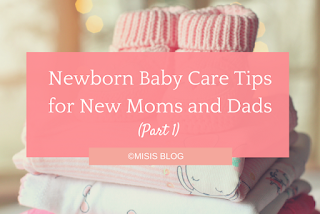This is the second part of the Newborn Care Tips series.
In the first part, we talked about newborn baby care tips on sleeping, feeding/breastfeeding, and diaper changing.
If you want to know more about the aforementioned topics, head on to Newborn Baby Care Tips for New Moms and Dads (Part 1).
Here, we'll talk about bathing a newborn baby, caring for the cord stump, and soothing a fussy and crying baby.
Bathing
How to bathe a newborn baby:
- Frequency of baths: In colder countries, it's normal to bathe/sponge bath a newborn for just 3 times a week on the first few weeks. In hot and humid countries like the Philippines, it's recommended to bathe your newborn baby every day. Of course, care should be given to prepare lukewarm bath water and to use hypoallergenic baby soap to avoid irritation.
- Preparation: Always prepare all the things needed before bathing your baby: towel, changing pad, clothes, diaper changing paraphernalia, baby bathtub and bath seat (if applicable), baby soap/shampoo, etc.
- Method of bathing: Use a shallow basin (or a baby bathtub), always test the water's temperature beforehand, and hold the baby with one hand or use a baby bath seat for better support. Be always sure to support your baby's head, neck, and back to avoid injuries. Your other hand should pour small amounts of water on the baby's head and body. It's advised not to use sponges when lathering soap and shampoo to your baby's sensitive skin; washcloths are preferred, or just use your bare hands.
- Soap/shampoo: Use mild, unscented, hypoallergenic soap/shampoo that's specially formulated for babies. Dilute liquid soap and shampoo with water before application.
Umbilical cord stump care
How to clean and care for the umbilical cord stump:- Frequency of cleaning: Daily cord stump care should be done, once a day. Use a cotton ball dipped in clean water or 70% isopropyl alcohol, and then squeeze out the liquid onto the stump. Also clean the base of the stump in a gentle circular motion. Keep the area of the stump clean and dry to avoid infection, and fold the diaper away from the area of the stump.
- When the umbilical cord stump naturally falls off: The umbilical cord stump typically falls off after 1 to 3 weeks after birth. Never attempt to pull off the cord stump; it will naturally fall off on its own. Once the stump falls off, daily cord dressing should be done until it heals. Use cotton buds/swabs dipped in clean water or alcohol and gently clean starting from the inside going out.
- Are abdominal binders needed: Do not apply abdominal binders. It can act as a medium for bacterial infection.
Crying and soothing a fussy baby
How to soothe a crying and fussy baby:- Why a baby cries: Babies cry for a number of reasons, so be sure to check if her diapers are soiled, the time when she was fed last, if the temperature in your room is too hot or too cold, or if she's coming down with something. Often, babies cry simply because they just want to be held. Trust your intuition.
- Skin-to-skin, swaddling, and cuddling: Babies are used to the warmth and soft comforts of the womb. As much as you can, hold your baby, cuddle, and have skin-to-skin contact—these methods mimic closely to the natural environment of the womb, as with swaddling. Singing and rocking your baby are also recommended ways to soothe a crying baby. Find what works best for your little one.
About colic:
If your baby incessantly cries for 3 hours or more a day, 3 or more days a week, for 3 straight weeks, she may have colic.
Colic is described as excessive crying for no apparent reason, though the reasons stem mainly from digestive problems.
Often, infrequent burping after feeding could cause colic, so be sure to burp your baby right after every feeding.
In the Philippines, manzanilla oil (chamomile oil) is often used to soothe colic; this is usually rubbed on the baby's tummy and fontanels, though be sure to check if your baby might be allergic to the oil.
If you suspect that your baby has colic and none of the soothing practices could pacify your baby, see your pediatrician.
It should be taken note, though, that the tips I rounded up here are from my own personal experience and from various advice I received from my pediatrician, parents, and other mom friends.
Again, every baby is different, and it's important to take cues from your baby whether they positively respond to the type of care you're giving them or not.
___
Again, every baby is different, and it's important to take cues from your baby whether they positively respond to the type of care you're giving them or not.







